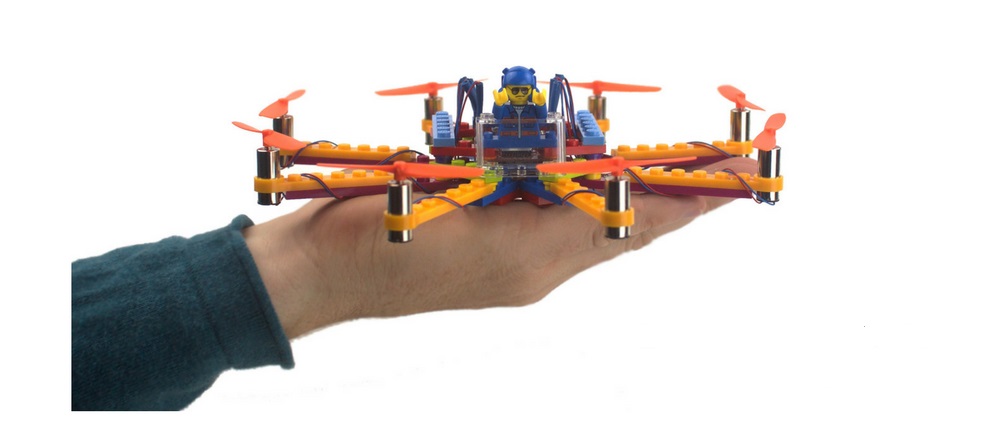Using Lego blocks to build a model of the Starship Enterprise is something a lot of us nerds have either done or attempted to do. The thing is, no matter how detailed or accurate we got, the replica would never take to the skies like the spacecraft Captain Kirk commandeered. Now you can have your Lego models and fly them too; DIY Lego drones are officially a thing thanks to startups like the San Francisco-based Flybrix.
The startup has launched sales of a drone kit which anyone can use to design their own quad-, hex-, and octocopters. Inside the kit is an assortment of 50 or more Lego bricks, which serve as the building blocks for your volant creations. Also in there are quick-connect propellers and motors, which are what convert the models to machines.
Before getting to the design part, first things first: the Lego drones need to be built around what Flybrix calls a flightboard. It’s basically a pre-programmed PCB board onto which you can connect the LiPo battery that powers the entire thing, and any other motors or electrical components you’d like to go on there. Drones need to be designed in such a way that the flightboard is set up safely inside the structure. The kit comes with a USB LiPo battery charger cord to make it simple to keep the 3.7v battery well-supplied.
Flybrix’s Lego drones can be operated using a standard RC controller. The controllers are a standard inclusion on the Deluxe kits. The Basic kits don’t come with an RC controller, but there is the option of purchasing an RC Expansion Pack priced $80 at a later time.
Another option users have is to control their drones using the companion app that’s available on Apple or Android devices. The app communicates with the drones over Bluetooth, and mimics the arrangement of controls in a physical controller—experience with an RC controller will help if you’re trying to pilot a drone with an app for the first time.
What makes Flybrix’s product so appealing is that there is a little something in there for various user types across age groups and drone-flying experience. It’s designed for those 14 years of age and older. For younger users, it’s a way to pick up a fun hobby while also getting familiar with concepts in aviation and electronics. It’s also nice to have a plaything that can crash and break without ruining the mechanics or the experience; that’s the whole point of it.

For more advanced users, Flybrix offers an Arduino-compatible ARM Cortex M4 processor that’s the brains of the operation. The flightboard PCB houses a magnetometer, barometer, SD card slot, and ADC converters. It carries plenty of firepower out of the box, but it’s also possible to add GPS and WiFi modules.
If all those bells and whistles weren’t cool enough, it’s also possible to mess around with the software that runs Flybrix’s Lego drones. The codebase is all open-source; you can access it here on Github. To configure flight behavior without diving into code, there’s a laymen-friendly Chrome extension. It can also be used to record and review data from the sensors on board.
Flybrix was founded in 2015 by Holly Kasun, Robb Walters, Amir Hirsch; there are degrees from MIT, Caltech, and University of Wisconsin-Madison between them. Hirsch is also the co-founder of Zigfu, a service that simplifies the process of making apps for Kinect. The startup declined to give CNN funding information, but they’re well on their way to drumming up greater investor interest if the initial buzz around the product is anything to go by.
The Basic and Deluxe edition Flybrix drone kits are being offered at an introductory price of $149 and $189 respectively. They will cost $189 and $249 after the introductory period. Units can be purchased on the company website.


